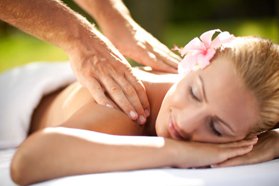 Massage Therapy
Massage Therapy
Massage Therapy is the hands on manipulation of the soft tissues of the body including muscles, connective tissue, tendons, ligaments, and joints. Massage can relieve muscle tension and pain, increase mobility, enhance function, and aid in the healing process. Massage promotes relaxation of the mind and body by increasing circulation, releasing endorphins, and improving the function of the immune system. Massage therapists use a variety of techniques (see below) that, along with prescribed client self care, help to facilitate improved health and well being.
Swedish Massage
Swedish massage is one of the most common types of massage therapy in the West and is what most people think of when they think of massage. It is used to help relieve pain and support the proper functioning of muscles and joints. There are several specific strokes used in Swedish massage: effleurage (gliding), petrissage (kneading), stripping (deeper gliding along the entire muscle), tapotement (rhythmic tapping), friction (a cross-fibre technique used to break down scar tissue) and vibrations/shaking (gentle movements to reduce pain and increase relaxation).
Triggerpoint Therapy
Triggerpoints are often referred to as “knots”. These are nodules that can form in muscle tissue. They can be quite painful and can transfer referral pain to other joints and muscle in the area. Triggerpoint therapy locates and releases these “knots” through the application of deep tissue techniques directly to the site. Therapists will often apply pressure directly to the triggerpoint until it releases however, this technique can be modified depending on the client’s pain tolerance.
Deep Tissue Massage
Deep tissue massage is best for relieving severe tension in the muscles and tissues. The therapist’s goal will be to access and manipulate different and deeper levels of muscles as well as connective tissue (or fascia) to relieve pain or speed rehabilitation.
Lymphatic Drainage
This is a technique that is used to reduce swelling. It consists of a series of gentle strokings over the body which can be done on the skin or over clothing. Many clients find the technique to be relaxing however it can be a very effective way of relieving tired, puffy eyes, and swelling in the ankles and legs due to pregnancy. This practice is also beneficial to individuals suffering from post-surgical swelling, swelling from recent or acute injuries, and lymphedema. This technique has been found to be particularly effective for women recovering from breast cancer related surgeries.
Joint Mobilization
This is a type of passive movement where the therapist will gently move one or more of the client’s joints within its natural range of motion. The purpose of this technique is to relieve joint pain and/or stiffness and to maintain or improve range of motion, as well as to bring new fluid to the joint to help improve joint health.
Myofascial Release
This is a safe and effective hands-on technique that involves applying gentle sustained pressure into the myofascial connective tissue restrictions to eliminate pain and restore motion. Myofascial release is performed directly on skin without oils or lotion. This enables the therapist to accurately detect fascial restrictions and apply the appropriate amount of sustained pressure to facilitate release of the fascia. Fascia is a specialized system of the body that has an appearance similar to a spider’s web. It is densely woven and covers and penetrates every muscle, bone, nerve, artery and vein, as well as all of our internal organs including the heart, lungs, brain and spinal cord. The most interesting aspect of the fascial system is that it is not just a system of separate coverings. It is actually one continuous structure that exists from head to toe without interruption. In this way you can begin to see that each part of the entire body is connected to every other part by the fascia, like the strands in a spider’s web.
Relaxation Massage
The goal of a relaxation massage is to decrease stress and anxiety and help relieve insomnia and headaches. There are numerous techniques that can be incorporated into a relaxation massage including Swedish massage and lymphatic drainage. Therapists will typically use lighter pressure however pressure will be modified to the client’s preference. If you are someone who prefers deeper pressure in a massage, you can certainly enjoy that in conjunction with your relaxation massage.





